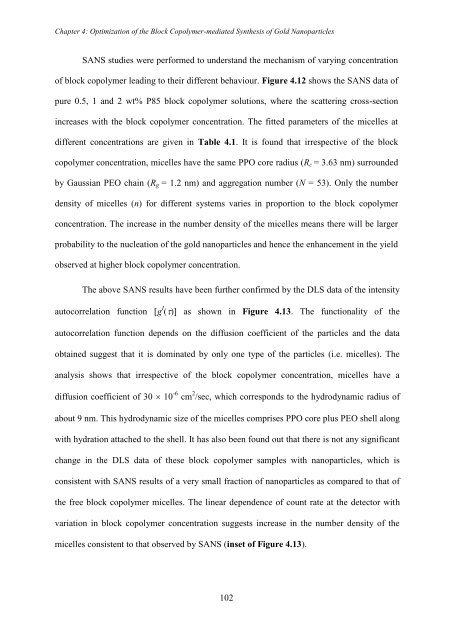PHYS01200704032 Debes Ray - Homi Bhabha National Institute
PHYS01200704032 Debes Ray - Homi Bhabha National Institute
PHYS01200704032 Debes Ray - Homi Bhabha National Institute
You also want an ePaper? Increase the reach of your titles
YUMPU automatically turns print PDFs into web optimized ePapers that Google loves.
Chapter 4: Optimization of the Block Copolymer-mediated Synthesis of Gold Nanoparticles<br />
SANS studies were performed to understand the mechanism of varying concentration<br />
of block copolymer leading to their different behaviour. Figure 4.12 shows the SANS data of<br />
pure 0.5, 1 and 2 wt% P85 block copolymer solutions, where the scattering cross-section<br />
increases with the block copolymer concentration. The fitted parameters of the micelles at<br />
different concentrations are given in Table 4.1. It is found that irrespective of the block<br />
copolymer concentration, micelles have the same PPO core radius (R c = 3.63 nm) surrounded<br />
by Gaussian PEO chain (R g = 1.2 nm) and aggregation number (N = 53). Only the number<br />
density of micelles (n) for different systems varies in proportion to the block copolymer<br />
concentration. The increase in the number density of the micelles means there will be larger<br />
probability to the nucleation of the gold nanoparticles and hence the enhancement in the yield<br />
observed at higher block copolymer concentration.<br />
The above SANS results have been further confirmed by the DLS data of the intensity<br />
autocorrelation function [g I ()] as shown in Figure 4.13. The functionality of the<br />
autocorrelation function depends on the diffusion coefficient of the particles and the data<br />
obtained suggest that it is dominated by only one type of the particles (i.e. micelles). The<br />
analysis shows that irrespective of the block copolymer concentration, micelles have a<br />
diffusion coefficient of 30 10 -6 cm 2 /sec, which corresponds to the hydrodynamic radius of<br />
about 9 nm. This hydrodynamic size of the micelles comprises PPO core plus PEO shell along<br />
with hydration attached to the shell. It has also been found out that there is not any significant<br />
change in the DLS data of these block copolymer samples with nanoparticles, which is<br />
consistent with SANS results of a very small fraction of nanoparticles as compared to that of<br />
the free block copolymer micelles. The linear dependence of count rate at the detector with<br />
variation in block copolymer concentration suggests increase in the number density of the<br />
micelles consistent to that observed by SANS (inset of Figure 4.13).<br />
102

















